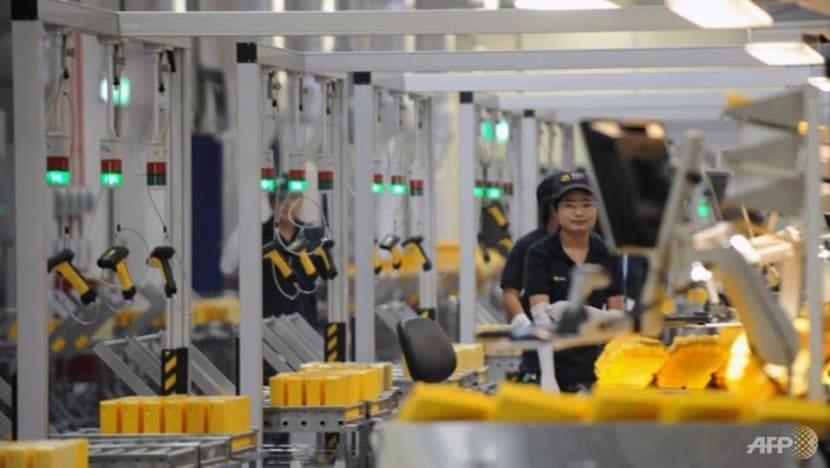Some economic bright spots remain for Singapore despite the overall challenging conditions

File photo of a manufacturing facility in Singapore. (Photo: AFP/Roslan Rahman)
SINGAPORE: With global production lines resuming operations, TranZplus Engineering’s Nelson Lim is confident business will pick up in the coming months.
The precision engineering firm’s chief executive said that orders had fallen by 20 to 30 per cent during Singapore’s “circuit breaker” between April and June - a period that largely corresponded with lockdowns in the rest of the world.
His company provides components to semiconductor manufacturers in Singapore, which in turn produces chips for technology firms.
But with the roll-out of 5G and growing need for data centres, Mr Lim is expecting sales to climb for the rest of the year. Already, business is “back on track” as orders from several multi-national companies have come in, he said.
His firm has also gone into the agriculture sector. He is in the midst of setting up an indoor farm that will open in the first quarter of next year.
Companies like TranZplus have emerged as one of the businesses fortunate enough to be doing well amid the economic fallout from COVID-19.
Several sectors have remained resilient at a time when the economy is seeing many sectors struggling, according to the quarterly economic report published by the Ministry of Trade and Industry on Tuesday (Aug 11).
While manufacturing output dipped by 0.7 per cent year-on-year on the whole, precision engineering, electronics and biomedical manufacturing expanded by 4.5 per cent, 5.6 per cent and 11 per cent respectively.
READ: Singapore narrows 2020 GDP forecast range as economy sees record quarterly slump in Q2
Describing why each of these manufacturing sub-sectors grew, the report said that precision engineering’s growth was bolstered by the machinery and systems segment, which grew by 9.8 per cent due to “robust demand” for semiconductor equipment by major chipmakers.
However, its growth was tempered by a 9.3 per cent decline in precision modules and components output as COVID-19 dampened demand and disputed operations worldwide.
The biomedical manufacturing cluster’s expansion was driven by a higher level of production in the pharmaceuticals segment, while output in the electronics’ cluster was supported by the semiconductors segment, which in turn was driven by strong interest for chips from the 5G market, cloud services and data centres.
Within the retail sector, stores selling essential items - supermarkets and hypermarkets, and their smaller counterparts of minimarts and convenience stores - saw their sales volume go up by 56 and 8 per cent, respectively.
And among service providers, the finance and insurance sector saw an uptick of 3.4 per cent, as people still bought life insurance and reinsurance products, and digital adoption in the region shored up growth among credit card network players.
The banking segment also grew, although at a moderated pace, the report noted.
Proof that these industries have been doing well amid COVID-19 came in the form of companies declining the Jobs Support Scheme wage subsidies as well.
Among the players that either returned or donated the money were international banks Barclays, Citi Singapore and Bank of America, and pharmaceutical giants Boehringer Ingelheim and DSM Nutritional Products.
READ: Bank and pharmaceutical giant among firms that returned or donated Jobs Support Scheme wage subsidies
Economists say this growth is largely fuelled by individuals’ lifestyle patterns and medical needs amid COVID-19.
Ever since the outbreak began, companies and employees have had to spend more on digital goods and services as they shift into work-from-home mode, creating a renewed demand for electronic gadgets, said DBS senior economist Irvin Seah.
“If you want to have more of your workers working from home, you must make sure that they have the necessary electronic gadgets to help them work effectively from home,” he said.
A “very strong surge” in biomedical exports and output in the early part of the year contributed to pharmaceuticals’ relatively great performance, he added.
This surge in exports and outputs - driven by a requirement for active pharmaceutical ingredients (APIs) and medical equipment during the pandemic - has been somewhat sustained over the past few months, Mr Seah wrote in a report in June. APIs are used to produce medical drugs.
As for why the financial and insurance sector was able to achieve growth despite the weak economy, Mr Seah said the sector is “more resilient”, as the bulk of the business transactions are conducted remotely or online.
“As a result, the disruptions to the business activity in the financial sector has been less severe compared to the other sectors,” he said.
READ: DBS Q2 profit skids 22% on loan losses, says business steadying
The performance of the supermarket and convenience stores could be the outcome of people staying at home during the circuit breaker as dine-in services were banned, said Selena Ling, head of treasury research and strategy at OCBC Bank.
Retailers dependent on online sales have probably benefited from the pandemic as well, noted Mr Seah.
KNOCK-ON POSITIVE EFFECTS
But experts had mixed views on how much the expanding sectors could help the economy and labour market as a whole.
CIMB Private Bank economist Song Seng Wun said these sectors would definitely have a knock-on positive effect in jobs.
“As long as companies invest, plants and machinery, the multiplier is job creation, which is why in a recession, we don’t have these kinds of spots in the economy that creates opportunity for investment,” Mr Song said.
“If some sectors are still growing, some sectors still need the plants and machinery, that will have the spillover effect on new investments, new jobs.”
He added that as long as someone is employed, they will have income which they will spend, and this will have a positive ripple effect on the economy as a whole.
Expanding sectors could also create temporary employment opportunities for displaced workers from other sectors, said Ms Ling. This includes jobs including safe distancing ambassadors, swabbers, or people temporarily working in the grocery management supply chain.
READ: COVID-19: 24,000 offered jobs, work attachments under SGUnited package between March and July
TranZplus’ Mr Lim said he plans to tap on the Government’s career conversion programme to bring in new faces. It currently has 57 employees and is still in hiring mode.
Apart from sales employees, it needs six more workers in its manufacturing division - quality engineers, machinists and production planners. And for its upcoming farming venture, it needs about 40 to 50 more people.
Other analysts felt the knock-on effect would be limited.
“For example, (the) hospitality and aviation industries would not benefit from any of the relatively better performance in some of the other clusters, because ultimately, what drives the business over there is tourism,” Mr Seah said.
He also said in his June report that the pharmaceutical industry is the least integrated with other industries, so the positive spin-offs for the rest of the economy will be marginal.
“The “stay home” phenomenon may have spurred fresh demand for electronic gadgets, sustainability remains questionable amid a global recession,” he wrote.
The manufacturing sector is primarily externally oriented, said HL Bank’s senior treasury strategist Jeff Ng, and some of these sectors are not as labour-intensive; effects on jobs are marginal.
"UNEVEN RECOVERY" AHEAD
Even with these bright spots, the economy and the labour market still faces tough times ahead, economists told CNA.
This will be an “uneven recovery”, said Mr Seah, adding that recovery will “feel very differently” for different groups of workers.
“Some sectors - manufacturing as a whole, financial services, ICT (infocommunications and technology) will continue to outperform, but there are some sectors that will continue to struggle.
“You can expect that workers in the aviation, tourism, maybe even construction (industries) … they will definitely feel the stress and the pressure, and they will struggle because that sectors will underperform and companies in those sectors will definitely be adversely affected,” he said.
All the sectors he listed that are in troubled waters performed poorly last quarter, the MTI report highlighted.
Year-on-year figures showed that construction contracted 59 per cent, transportation and storage - which includes air transport - shrunk 39 per cent, and the accommodation and food services sector - an indication of how tourism is doing - contracted by 41 per cent.
And the outlook remains bleak. For example, it said that in the aerospace segment, “a more gradual than-expected easing of border restrictions and sluggish demand for global air travel are expected to lead to continued soft demand for aircraft maintenance and repair work.”
READ: COVID-19: Singapore Airlines offers cabin crew early release, retirement to further cut costs
Even among sectors that are generally doing well, not every player benefits.
Sales at zero-waste retail store UnPackt have fallen since the circuit breaker, its founder Florence Tay said. Compared to pre-COVID-19 levels, it fell by 90 per cent during this period compared at its outlet in the central business district, and 40 to 50 per cent at its outlet in Upper Thomson - even after it launched its delivery service in the middle of the two-and-a-half months.
Ms Tay thinks retail sales were hit because their usual customers did not want to travel too far with their containers to pick up their necessities - especially with the authorities discouraging people from going out - and went to a grocery store closer to their homes instead.
She also stopped selling non-perishable merchandise to keep in line with the ban on non-essential retail services.
Its corporate arrangements were also hit hard, as many offices no longer needed to fill up their pantries, and external engagements were put on hold. Ms Tay has since tried to pivot by delivering individual ‘care packs’ to the companies’ employees, and holding workshops on sustainable living online.
But Ms Tay thinks she will be able to tide through this year without letting go of anyone.
“We are trying to keep our people,” she said, especially since they are a social enterprise that hires individuals like single parents and seniors that need the job.
The economic fallout from the pandemic shows how important diversification is, said the MTI report.
“In the case of the manufacturing sector, even though the pandemic has affected the M&OE (marine and offshore engineering) and aerospace segments disproportionately, segments such as pharmaceuticals, semiconductors, and machinery and systems have helped to provide some support to the sector and by extension, the Singapore economy,” it said.
“Nonetheless, downside risks to the growth of the manufacturing sector remain, including the risk of a major resurgence in COVID-19 infections globally which could weaken external demand significantly, and heightened geopolitical tensions.”
Recovery is certain but it will be at a gradual pace, Mr Ng said, as the world learns how to adapt to COVID-19 and safe distancing measures, while the chances of getting a vaccine increases as each day passes.
“We’re expecting a very gradual kind of improvement to normal levels, and I think we can only see a return back to pre-crisis level, economic activity, around mid of 2021,” he said.
BOOKMARK THIS: Our comprehensive coverage of the coronavirus outbreak and its developments
Download our app or subscribe to our Telegram channel for the latest updates on the coronavirus outbreak: https://cna.asia/telegram

















